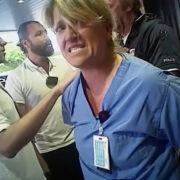March 30th is known as National Doctors’ Day in the U.S. It’s a way to celebrate all of the hard work America’s doctors and physicians do for their patients and the medical industry at large.
Many doctors have taken on a new role during the pandemic by developing followings on social media. Some providers use these platforms to educate and inform, while others just want to entertain.
Will Flanary, an eye surgeon in Portland, OR, has amassed over 2.5 million subscribers across TikTok, YouTube, and Twitter, where he regularly parodies various aspects of the medical industry. His style of comedy turned out to be just what the doctor ordered.
Spreading Joy (and Insight)
Flanary often goes by the name Dr. Glaucomflecken online. It’s just one of many fictional characters that he’s created over the last few years. He addresses various problems in the healthcare system using short skits that are full of jokes.
“That’s why I love building this Glaucomflecken General Hospital of characters,” Flanary said. “I can be pretty specific with different areas of medicine and create this world of, honestly, pretty dysfunctional people. But it’s funny.”
Each character specializes in a different type of medicine, which lets Flanary explore a wide range of themes in the industry.
There’s a careless emergency medicine doctor that always wears bicycle gear, a sweet but overly studious pediatrician, the brutish orthopedic surgeon, an alarmist dermatologist that regularly diagnoses mysterious spots and moles, and a meticulous medical scribe. All of them have eccentricities that would send any patient running for the hills.
Flanary is one of many providers using social media to develop a following, but he’s one of the few trying to make people laugh. Medical experts that study social media and medicine say doctors can easily offend or trigger their patients if they take a bit too far or make a joke at their patient’s expense. In some cases, medical influencers may be willing to do just about anything to increase their following, which can lead them to share false, risqué, or misleading content.
But Flanary has managed to transcend controversy by striking just the right note.
“What I think [Flanary] does well in general — and perhaps why he’s never been canceled — is that his humor is typically one of two things: wholesome, or relatable to everybody within the medical community,” said Sarah Mojarad, who teaches a course on social media for doctors and scientists at the University of Southern California. “These are things medical students have experienced, that residents have experienced — it’s all relatable.”
Many of Flanary’s jokes focus on common problems in the healthcare industry, including under-staffing, insurance and billing issues, and doctors that take themselves too seriously. He said he hopes his audience walks away “feeling like somebody understands.”
He also wants to cast doctors in a new light by showing off his sense of humor.
“There’s this prevailing notion that you can’t do the things I’m doing on social media because it’s not professional,” he said. “You can’t tell jokes. You can’t talk about the problems that you have in your job without sacrificing professionalism. And what I’ve learned is that that is not the case at all. People want the opposite. People want their doctors to seem like real people who are relatable.”
Flanary first started the project out of boredom during the first few months of the pandemic. His private practice closed, forcing him to spend more time at home.
With a background in satirical writing, he found himself creating short-form content for TikTok and Twitter.
“I checked it out and it seemed perfect,” Flanary said. “A short format, very easy to edit and shoot, and it would work on my schedule. I could attack all these topics that I’d been discussing on Twitter just with boring words, but now I could approach it in a different way and do something new.”
He started out with middling success, but his channel quickly went viral after he suffered from ventricular fibrillation cardiac arrest. His wife noticed his symptoms and performed CPR until an EMT arrived and shocked his heart to get it working again.
Flanary spent three days in the ICU, which led to a dispute with his insurance company. He used the experience to create one of his most popular videos where he plays two roles: a patient that’s stuck with a massive bill and an insurance customer service agent that calmly explains to the patient that they should’ve gone to an in-network provider even though they were unconscious.
“It really did kick off with the insurance problems,” Flanary said. “I saw, ‘Oh there’s a big appetite for this. This resonates with a lot of people.’”
Like many providers, Flanary takes issue with “institutions preying on people who are less powerful than them,” but instead of going into an angry tirade, he turned his frustration into a punchline.
He points the finger at the healthcare system itself, not individual patients, or providers.
“I always make sure that the object of ridicule is clear,” Flanary said. The health care system is laden with power dynamics, “and patients are at the bottom,” he said, “so I should never be perceived as making fun of patients, because that’s not going to go OK.”
Working at the private practice gives him the freedom to develop material online. He spends most of his days doing cataract surgeries and eye exams, but his nights and weekends are for getting into character.
“I’m fortunate to have this nice job that gives me a nice living that’s always there,” he said. “So, this all feels really low stakes. I feel like I can just try these things and see where it takes me.”
















